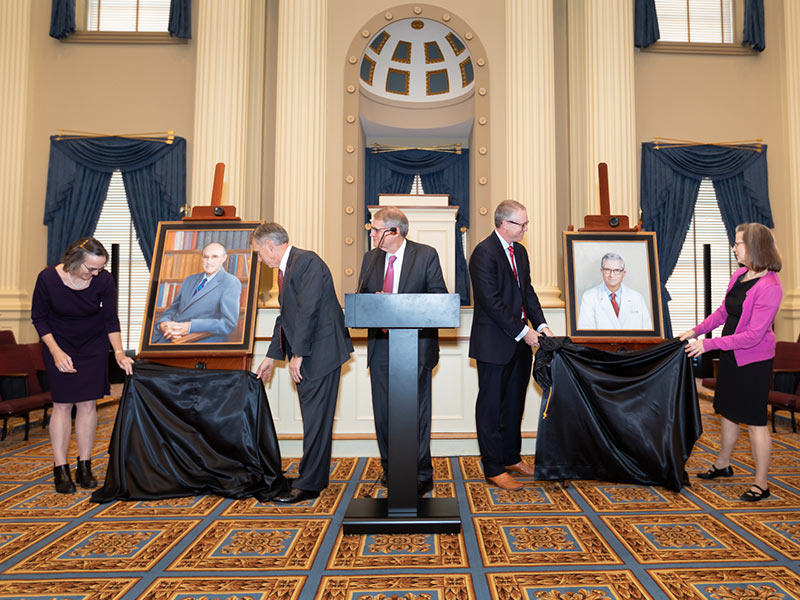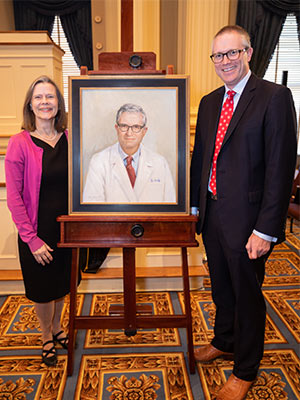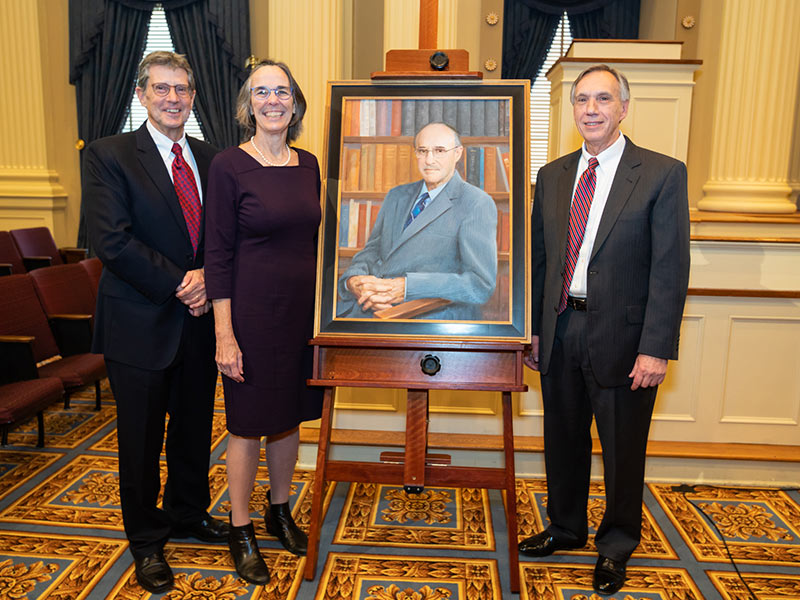Two frames of mind: State Hall of Fame dedicates Guyton, Hardy portraits

Tuesday’s ceremony dedicating two Mississippi Hall of Fame portraits drew some 80 guests – roughly the number of terms and titles trotted out to do justice to the legacies of the men portrayed between the frames: Dr. Arthur C. Guyton and Dr. James D. Hardy.
“Master teacher,” “hero,” “innovator,” “role model” and, most of all, “giant” – these were among the accolades echoing in the House of Representatives Chamber in Jackson’s Old Capitol Museum the day their official portraits were unveiled.
Of all the distinguished figures who have taught, researched and healed at the University of Mississippi Medical Center, none were more prominent than Guyton and Hardy “in terms of their innovative and enduring contributions to their respective fields,” said Dr. LouAnn Woodward in her remarks.
Woodward, UMMC vice chancellor for health affairs and dean of the School of Medicine, was a 1991 graduate of the School of Medicine and Guyton’s and Hardy’s student.

The founding chair of surgery at UMMC, Hardy led a team that performed the world’s first lung transplant, in 1963; the following year, he and his team transplanted a chimpanzee heart into a dying man, completing the first heart transplant into a human.
“It was not easy to be a pioneer in transplant in the 1960’s,” said Dr. Chris Anderson, UMMC professor and chair of surgery, during his dedicatory address. Those who defied the mood of the times “put their careers on the line,” he said.
“But they had grit … . They were resilient. I think they understood the importance of what they were doing.”
Known as “a man of “vision and perseverance,” as Anderson put it, Hardy was recruited to the Medical Center at age 38 to build a Department of Surgery; he held the department chair for 31 years.
For his contributions to the state, Hardy was elected to the Hall of Fame in 2016 by the Mississippi Department of Archives and History board of trustees whose current president, Kane Ditto, presided over Tuesday’s ceremony.
Guyton, the seminal chair of the Department of Physiology and Biophysics, is renowned for his Textbook of Medical Physiology which, in its various, updated editions, remains the best-selling volume on the subject in the world.
Affected by residual paralysis from polio he had contracted as an adult, Guyton received a presidential citation in 1956 for designing a motorized wheelchair with joystick, special crutches and braces, and hoists for lifting patients. His research triggered life-saving improvements in the treatment of hypertension, heart failure and other cardiovascular diseases.

At age 29, Guyton overcame some skepticism about his youth and stamina when he became chair of the Department of Physiology at the University of Mississippi in Oxford before he and the department moved to the new Medical Center in Jackson in 1955.
He built “what many consider the premier physiology department in the country,” said Dr. John Hall, Arthur C. Guyton Professor and Chair of the department today. “He was a tremendous role model and inspiration. He had tremendous courage and kindness as well.
“No one had a greater impact on my career.”
At one point, Guyton invited Hall to join him in editing the ninth edition of the physiology textbook which remains popular, Hall said, because “it’s written for the students, not for the professors.”
Guyton was elected to the Hall of Fame in 2011.
Guyton and Hardy, both of whom died in 2003, are among 136 Hall of Fame inductees representing a host of political leaders, along with artists Walter Anderson and George Ohr, authors such Eudora Welty and Walker Percy, and civil rights leader Medgar Evers, who was sent to the Medical Center emergency room with a fatal gunshot wound while Hardy was performing the historic lung transplant.
Hardy’s and Guyton’s portraitist is Steve Moppert of Signal Mountain, Tennessee, a past winner of the National Portrait Competition’s best-in-show prize. The paintings will hang in the Old Capitol with the others whose totality represents the Hall of Fame.
The UMMC Department of Physiology and Biophysics sponsored the Guyton portrait. Presenting Hardy’s were friends and family, among them the four daughters he brought up with the late Louise Scott Sams Hardy, who “kept him grounded,” Anderson said.
Two of their children earned medical degrees and two earned Ph.D.’s, including Dr. Bettie Winn Hardy Story of Dallas, Texas, who attended the ceremony.


